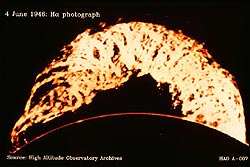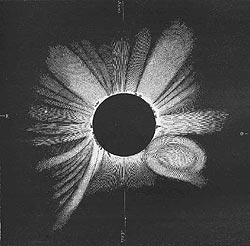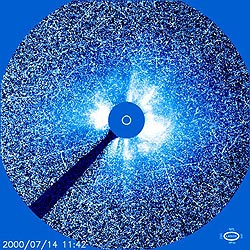
Sun-Earth Day 2007 presents: Living in the Atmosphere of the Sun
Our sun can sometimes explode into violence on a scale that boggles the mind.
ISSUE #56: CORONAL MASS EJECTIONS
Although our sun is luckily a very steady and reliable companion to life on Earth, sometimes for no apparent reason it erupts into violence on a spectacular scale beyond anything that humans have direct familiarity. The smallest incandescent storms can span continents or whole planets and last for hours...much like a volcanic eruption. The most exciting of these are the Coronal Mass Ejections, which have been seen for decades but only recently understood with any clarity.
The first solar mass ejection was probably witnessed during the total solar eclipse of July 18, 1860 (See Technology Through Time article #37 and a sketch of what was seen appears in Figure 1. By the time extensive telescopic investigations were conducted on the sun in the 1940's, astronomers had witnessed thousands of explosions of matter from the solar surface. The most dramatic of these was the Great Eruptive Prominence of 1946 shown in Figure 2.
During the early 1970's, satellites such as the Solar Maximum Mission (SMM) and Skylab caught many of these 'coronal transcient' events, but the moniker 'Coronal Mass Ejection' wasn't used to discriminate among the many different kinds of explosions until 1973 when the first 'modern' detection of a CME was made on December 14, 1971 by astronomer R. Tousey (1973) using the 7th Orbiting Solar Observatory (OSO-7). This satellite employed the first coronagraph in space, allowing crystal clear observations of the sun's corona. He discovered that these eruptions launched material into the solar corona, but that the material did not fall back to the sun but just kept going further away.

Figure 2: This erupting prominence was caught on June 4, 1946 by telescopes at the High Altitude Observatory in Colorado.
The satellite observations created a huge list of observational properties for 'CMEs', for instance: they follow the sunspot cycle in their frequency; their masses can be from 1 billion to 10 billion tons; they can travel at speeds from only a few hundred km/s to over 3000 km/s. Today, we can examine the latest images from satellites such as SOHO or STEREO to see the latest events. Careful studies of the underlying causes of these spectacular explosions of mater and energy have lead to many tantalizing discoveries.
CMEs often occur after loops of magnetic field lines (filaments) near sunspots are seen to move suddenly, or flaring activity erupts. Despite what one might think in seeing movies of CMEs in action, they are not actually gases (plasmas actually) launched from the solar surface itself. Instead, the matter in these expulsions comes from the tenuous solar corona itself. Powerful X-ray flares of classes M and X are often observed just before a CME outburst, especially during the more spectacular, high-speed eruptions. Most CMEs however are far less dramatic, slow-speed, and often have no X-ray flares to signal their launch. In many instances, no identifiable surface event can be found.
Why do they happen? Despite decades of research, no single cause has been found, possibly because so many different triggers exist .After all, all you need to observe is 'matter ejected from the sun' and it falls into the category of a CME!
The current, best, idea is that at the start you have a stable condition in which lines of magnetic force are anchored to the solar surface and are loaded with plasma forming a magnetic bottle in the shape of a giant, though invisible, horseshoe. At some later time, this stability is disturbed by some other event. Perhaps a flare eruption 'down below' in the photosphere or chromosphere, or some change in the magnetic field itself, is all that is needed. Like a helium balloon released, the collection of plasma and magnetic field becomes buoyant in the solar atmosphere and float away from the sun at ever increasing speed until the solar gravity can no longer hold them back.
Very few CMEs are a problem for us here on Earth, but those that are can do all manner of damage to satellites, electrical power systems, while at the same time giving us the thrill of seeing Northern Lights dancing across the evening sky.
A CME coming straight at the Earth looks like an expanding halo of light surrounding the sun, but visible only with instruments such as the SOHO Large Angle and Spectrometric Coronagraph (LASCO). Because high-energy particles often accompany the eruption, these particles travel at nearly the speed of light and cause intense 'snow' events in satellite imaging systems like the 'halo CME' event shown in Figure 4. After another few days, the slower-moving plasma arrives at Earth and causes intense magnetic storms, which lead to aurora sightings and some forms of spacecraft damage. By the way, only half of the halo CMEs we can see with our satellites are actually pointed at Earth. The other half are on the other side of the sun and pointed in the opposite direction!
Technology Through Time
2007 ISSUES
- #57: The Heliosphere
- #56: Coronal Mass Ejections
- #55: Solar Corona, Holes and Wind
- #54: Solar Flares... Oh my!
- #53: Solar Prominences
- #52: Sunspots from A to B - solar magnetism
- #51: The Transit of Mercury
- #50: Ancient Sunlight
- #49: Solar Energy
- #48: The Sun: From Cradle to Grave
View past issues
Authors and Designers
Space Weather Fact
Over $2 billion in satellite technology was damaged or destroyed during the last sunspot cycle.





